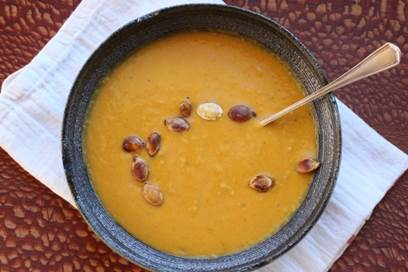By Hallie Hopkins, Education Program Assistant SNAP-Ed, OSU Extension Service/Tillamook County
Squash is known for its numerous varieties, differentiated in type by the summer and winter seasons. Summer squash are picked young when they are still mild and tender. They are much more perishable and are best if eaten immediately after harvesting. Winter Squash, however, are harvested when they are fully mature, have a sweet and starchy taste and can be stored for several months. Common winter squash varieties include acorn squash, buttercup, butternut, hubbard, sugar pumpkin and spaghetti squash. However, spaghetti squash is low in starch and high in fiber, so it cooks differently than other varieties. It tends to separate into strands when it is cooked, giving it an appearance of long string like noodles.
A popular variety, the butternut squash is an excellent source for Vitamin A. On cup of squash provides 163% of the recommended daily value of Vitamin A for women and 127% for men. Vitamin A can also be found in animal based foods such as liver, dairy products and fish. Other forms of vitamin A are found in deeply colorful fruits and vegetables such as carrots, broccoli, peas, spinach, and cantaloupe. Vitamin A is important for many functions of the body especially in vision, growth and immune function.
Winter squash tend to be fairly large which can make for lots of creative ways to use it. Judy Barbe, Registered Dietitian Nutritionist, used just one squash that yielded 5 different meals with enough squash leftover to freeze. Squash can be frozen and used in main dishes, soups, chili, and baked goods. Pack it in freezer bags and save it for up to one year. If the thought of trying to use up a whole squash is too intimidating, you can also purchase smaller varieties, frozen or convenience pre-cut squash.
For more healthy recipes from Judy Barbe, RDN, visit her website at www.livebest.info. Come and hear Judy present at the Eating Well, Being Well YOW event on March 11th at the new Extension Office. For more information and to register for this event: http://bit.ly/TillamookYearofWellness or call 503-842-3433
Thai Squash Soup
Judy Barbe, Registered Dietitian Nutritionist
8 Servings
Ingredients
2 teaspoons canola oil
1 small onion, diced
2 tablespoons red curry paste
1 teaspoon cumin
4 cups squash, cooked and cubed
One 13.66 ounce can unsweetened coconut milk
One 14.5 ounce can chicken broth, could substitute vegetable broth
1 tablespoons fish sauce
1 teaspoon brown or raw sugar
¼ teaspoon black pepper
Lime, zest and juice
Toasted squash seeds
Instructions
- In a 4-quart pan, over medium heat, add oil and onion. Cook 8-10 minutes, stirring occasionally, until onion is softened and transparent. If onion starts to brown, reduce heat.
- Add curry paste and cumin, stirring for 1 minute.
- Add squash, coconut milk, chicken broth, fish sauce, sugar, pepper and lime zest. Stir to combine.
- Bring soup to a boil then reduce heat to low. Simmer for 10 minutes until heated through.
- Serve it chunky or smooth. I ran mine through the blender for a minute.
- Top with a squeeze of lime juice and the toasted squash seeds.
- To toast squash seeds: scrape them out of the squash. Remove as much pulp as you can. Rinse in a bowl of water. In a separate bowl, sprinkle seeds with a teaspoon of canola oil and a ½ teaspoon of salt. Spread seeds in a single layer on a baking sheet. Bake at 325° for up to 60 minutes. Stir occasionally and keep an eye on them for browning. Remove pan from oven, place on calling rack. Seeds will crisp as they cool.
Nutrition Facts
Per serving: 631 calories, 9g saturated fat, 201 mg sodium, 15g total carbohydrate, 0 g dietary fiber, 3 g sugars, 3 g protein, 63% DV vitamin A, 23% vitamin C, 16% DV calcium and 16% DV iron.
Joachim, D., Schloss, A., & Handel, P. (2008). The Science of Good Food (pp. 536-539). Toronto, Ontario, Canada: Robert Rose Inc.
Dietary Reference Intakes
Judy Barbe http://www.livebest.info/soups/thai-squash-soup/

